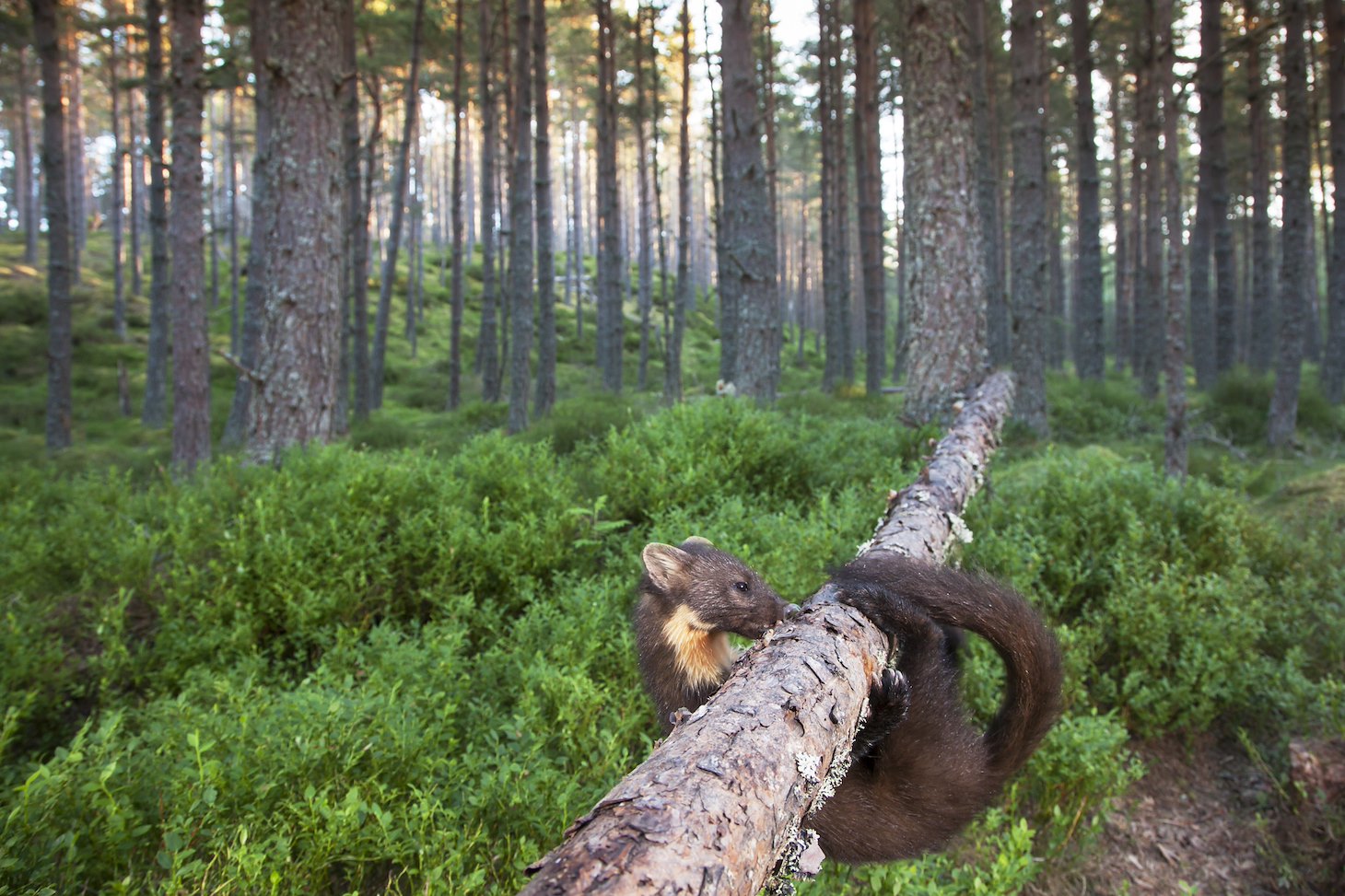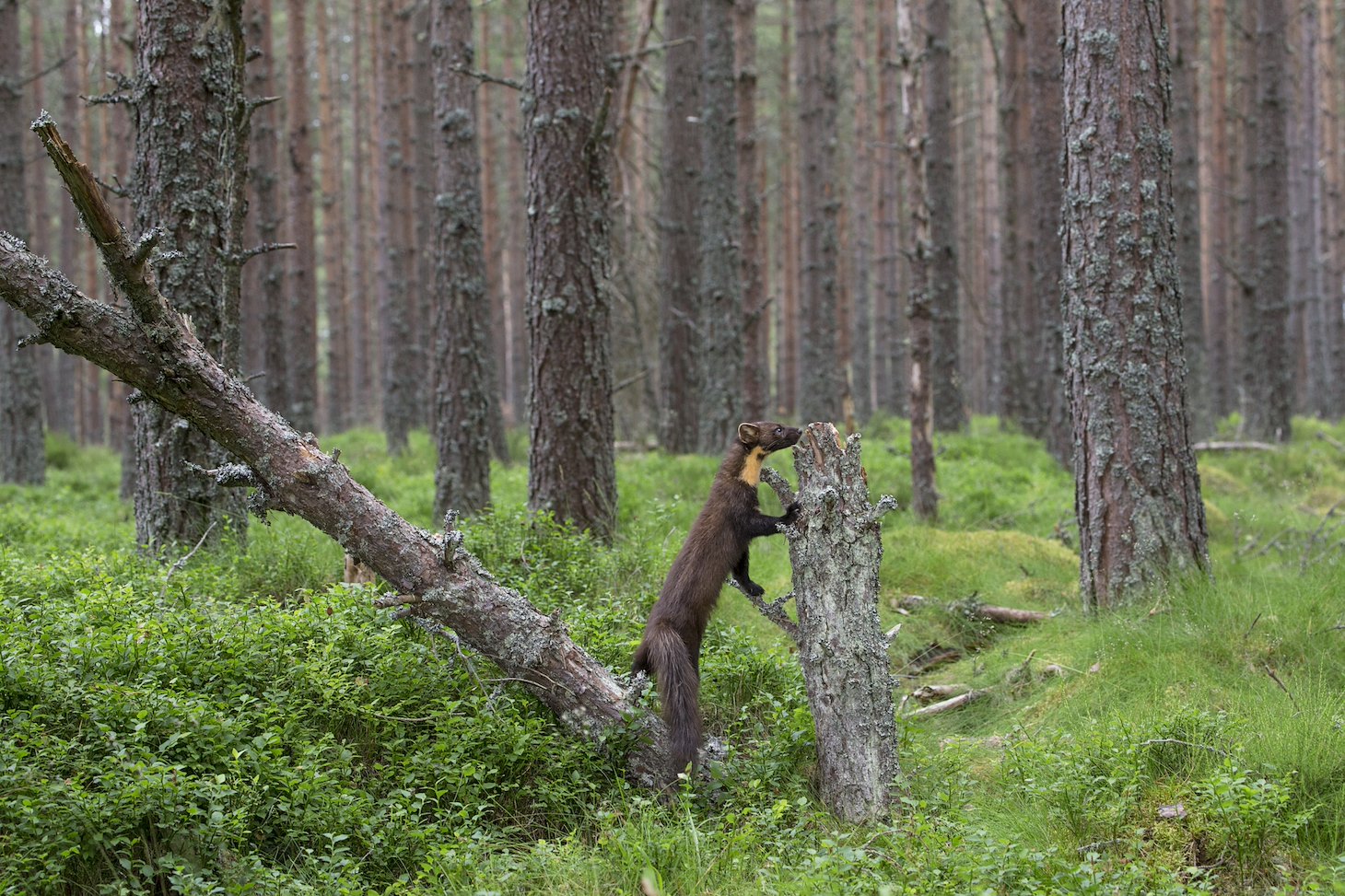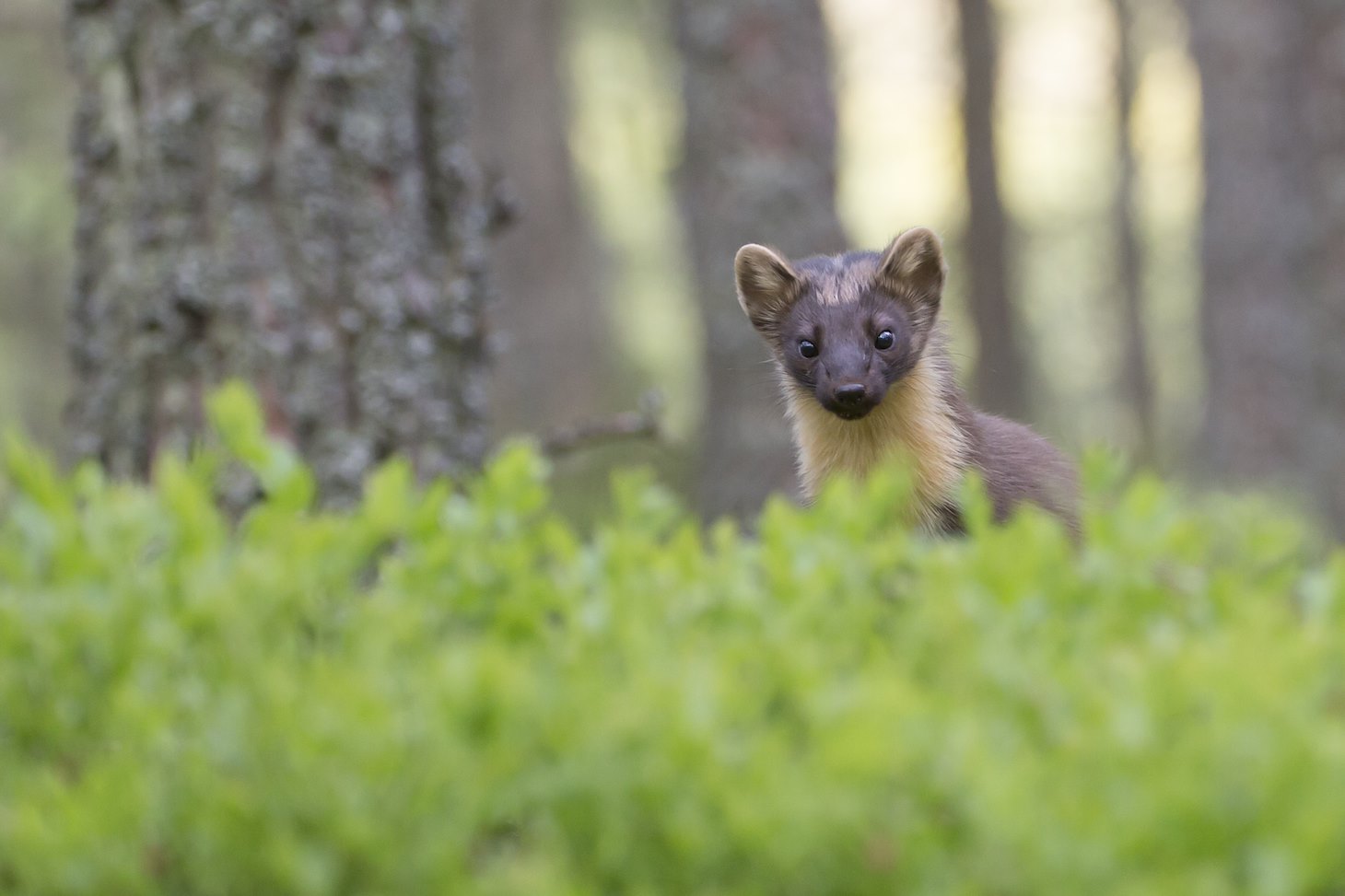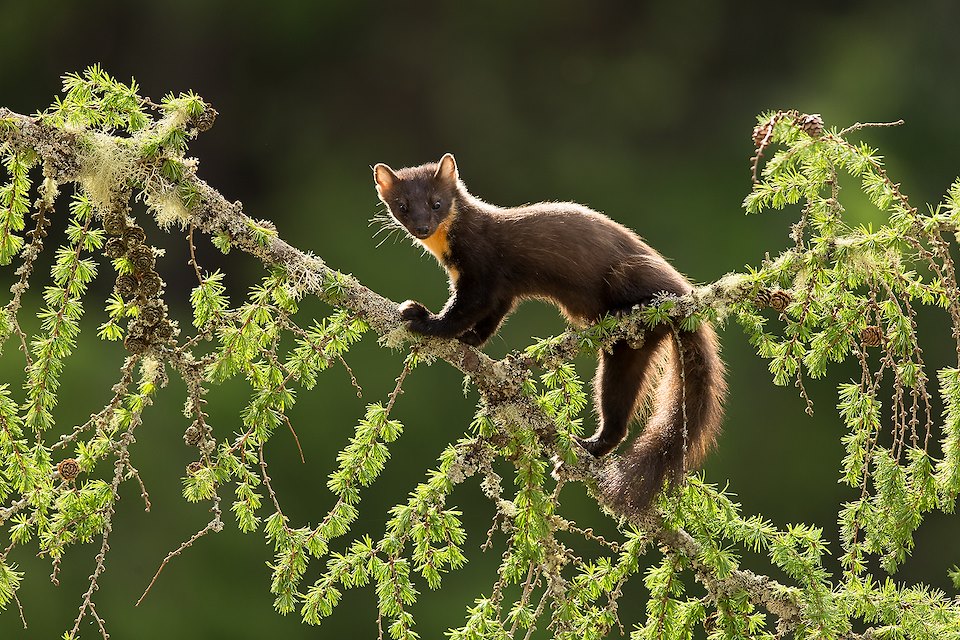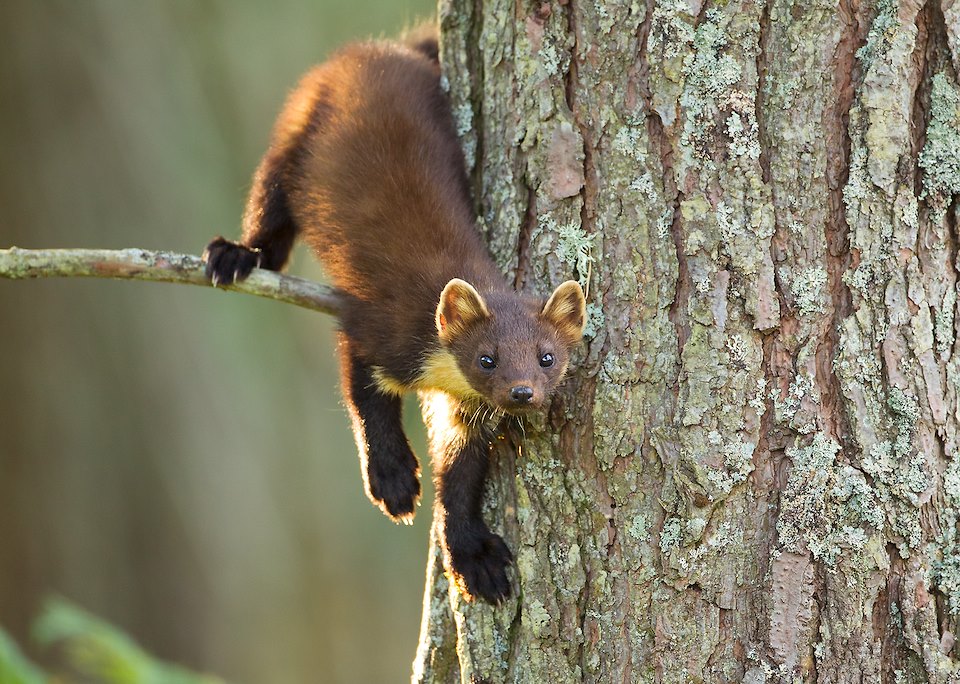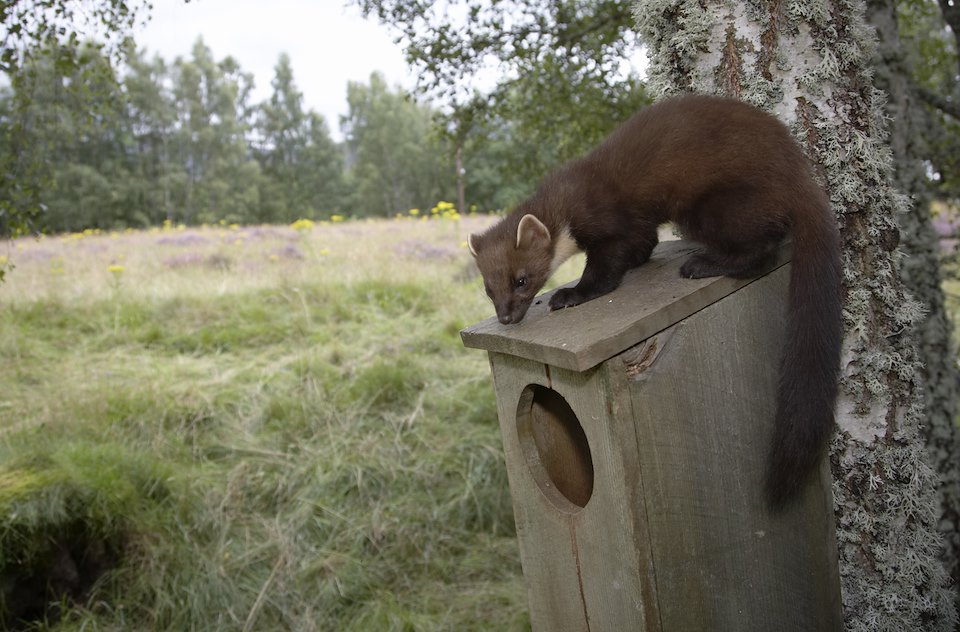The Return Of The Taghan
Despite centuries of persecution and habitat loss, pine martens have proven themselves to be survivors, and as they expand their range, they’re revealing some surprising secrets.
Even a dead pine marten leaves its mark. I won't forget that first sighting.
In front of me lay a beautiful cocoa-coloured animal brought into the public bar of my parent’s hotel in Kilchoan, on the Ardnamurchan Peninsula. It had been caught in a snare and then squeezed into a bloodied game bag. Now it lay on the table revealing an exquisitely furred body so soft to the touch. Its tail was full and bushy, the ochre-coloured patch at its throat dappled with dark brown blotchy markings. As it lay motionless, I saw its little foxy face revealing sharp teeth set firm in a macabre death grimace. I was eight years old, and I had never seen anything quite so lovely. I had been close to other dead animals but this one I recall had no odour. It is the reason that the pine marten bears the nickname sweet mart, while its relative the polecat is fou' mart – or foul mart, because of its pungent aroma.
At the end of the 1960s, even the lush Atlantic oakwoods of the Western seaboard were devoid of pine martens. We stood looking at this astonishing creature amid conjecture – was it a ferret, a polecat, a mink? No one seemed to be sure. Someone suggested a marten cat. Looking back now, this lack of knowledge proves how desperate things had become for the pine marten. The relentless persecution had rendered it so rare, it was almost lost to our memory.

The lush temperate rainforest that once fringed much of Scotland’s west coast would once have harboured many pine martens, which were historically Britain’s second most common carnivore.
The arboreal pine marten is undoubtedly the most glorious member of the diverse Mustelidae family that includes, the badger, stoat, weasel, polecat and otter, and like the rest of the group, it has many extraordinary traits, is adaptable, and strong for its size. The Gaels called it taghan, and in Scotland, it was also frequently called, mertrick.

In 1888, in his book, Wild Sports of the Scottish Highlands, naturalist and sportsman Charles St John wrote:
"The marten cat is accused by the shepherds of destroying a great many sheep. His manner of attack is said to be by seizing the unfortunate sheep by the nose, which he eats away, till the animal is either destroyed on the spot or dies a lingering death. I have been repeatedly told this by the different Highland shepherds and others, and believe it to be a true accusation."
Supposed eyewitnesses backed up the theory that the hapless marten was indeed a livestock killer. Referred to, and treated as, the ‘scourge of the glen’, the marten is another example of an animal damned by Victorian dogma: sheep slayer, a beast with a poisonous barb attached to its bushy tail, a filcher of poultry and eggs. The marten is guilty of only that last crime. Whatever the anti-predator brigade was imbibing at the time, we must give them full marks for their vivid imaginations.
Coupled with a catastrophic loss of native woodland due to fire, axe and over grazing, the odds against the pine marten were stacked high. Its luxuriant, exotic pelt also added to its downfall. In 1906 naturalist J. Harvie-Brown claimed that it was even rarer than the wildcat. The few remaining animals fled to the remotest corners of Scotland where they adapted their superb tree-climbing skills to scaling rocky outcrops where they sought dens high in inaccessible crags. Here they miraculously clung on by their pale-coloured, semi-retractable claws and were seldom seen.

Marten pelts are still widely available in many parts of Norway.
In 1988 an amendment to the Wildlife and Countryside Act of 1981 brought protection for the pine marten. Around a decade earlier, the mass planting of fast-growing commercial conifers also inadvertently aided a population recovery. Pine martens are omnivorous with a catholic diet. They relish earthworms and field voles and the dense tussocky grasses of the young forest fringes brought rich pickings. And as the monoculture tree canopy closed in, it offered safe, secret places to hide.
Today the majority of us no longer want to view the pine marten that previously swung husk-like from the gamekeeper's gibbet, through the barrel of a gun. Instead, the taghan has become an icon for a growing wildlife tourism industry, which has adopted the marten as a symbol of a nature-rich landscape. A network of viewing hides and self-catering cottages that supply the local martens with regular treats, means that with a bit of patience, these previously rare and elusive mammals can be enjoyed at close quarters across much of the Highlands. From a once detested varmint that polarised people’s perceptions, to an ambassador for an ecologically richer Scotland, the pine marten offers a glimpse into what else might be possible with a change in our attitudes.

Many self-catering cottages attract nightly visits from opportunistic martens.
As well as resurgence in Scotland, martens are beginning to leach into Cumbria and Northumberland. However, it is the exemplary work of the Vincent Wildlife Trust (VWT) and its partners that is helping the beleaguered population further south in Wales and England.
Social acceptance is a critical factor in the complex process of re-establishing lost or endangered species. For such projects to succeed, public opinion must always be a significant consideration.
Following two decades of detailed consultation and surveys, the VWT found that 91% of respondents wholly supported the idea of helping restore the pine marten population in mid-Wales.
Scottish Natural Heritage granted licences for some animals to be taken from areas of high population density, and between 2015-17, a total of 51 martens were successfully translocated to mid-Wales. The Welsh releases took place in secret forestry locations, and follow-up radio tracking and camera trapping has revealed that every year since, breeding has occurred and the martens are flourishing. In September 2019 the VWT reintroduced 18 martens to Gloucestershire's Forest of Dean. The hope is that this latest group of animals will eventually link up with the Welsh population.
Those who clutch at anti-pine marten straws are quick to suggest that their population recovery will be detrimental to our struggling red squirrels. However, following detailed research led by Emma Sheehy of Aberdeen University, both in Scotland and Ireland, the pine marten's role in red squirrel conservation has surprised many people. After the disastrous introduction of the non-native North American grey squirrel to England in 1876, red squirrel numbers have plummeted. Greys carry a lethal parapox virus, though they are immune to it themselves. However, when it infects a population of reds, there will be no survivors. Greys also outcompete the smaller red for a diminishing natural food source and are accused of damaging forestry with their bark stripping.

Though pine martens will predate red squirrels, recent research suggests that the slower, heavier grey squirrel is becoming a favoured prey item, aiding red squirrel recovery.
Where pine martens are regaining a foothold, the grey squirrel population is tumbling, but conversely, reds are thriving. Not only is the red squirrel swifter, lighter and more agile than the grey and can escape predation by reaching the thinnest branches, but it has co-evolved with the marten. Not so the grey. One of the most exciting results of this research is proof that the presence of native predators can help naturally with the removal of invasive species. Had the pine marten population been buoyant when our misguided forbears brought greys to the British Isles, would we still be faced with the problem of their insidious spread? This developing research also brings to the fore a basic ecological principle: that the removal of a predator from an ecosystem often results in catastrophic consequences.

For me the memory of that first deceased marten lingers but half a century on, things are indeed changing for the marten cat. Drizzle falls fizz-like on the steel-grey waters of Loch Maree, Wester Ross. The eerie, melancholy calls of black-throated diver echo beneath the bastion of brooding Slioch. On the mountain’s lower slopes, where wild goats graze, ancient contorted Scots pines eke out an existence between this rock and a hard place. On a moss-padded boulder close by, a pine marten dozes. It is cat-sized, curled into a neat doughnut, yet vigilant. If I move, it will instantly melt into the landscape as if it was never there. The wind is in my favour and I lie hidden in russet-coloured bracken beneath the bank, while it remains oblivious. Through binoculars, that lustrous pelt once so eagerly sought, glistens with raindrops. The creamy-yellow cravat, with its unique brown patches, makes it possible to identify individuals. There is movement. It rises and stretches out its lithe, gymnast’s body and dances into the crags above. Shortly a range of yattering, growling and hissing sounds indicate a dispute – two martens emerge facing one another in a standoff. Rain is running down my neck; the loch has vanished.
For the past twenty years, I have been relishing more and more pine marten encounters. Each experience, be it in a wild, remote and windswept part of Scotland, or my garden, fills me with a frisson of excitement and joy. Twisted scats are becoming increasingly prominent on my walks, a sign that pine martens are beginning to emerge from the bigoted beliefs of the past.
Their presence in gardens, where their every move is watched and recorded by eager owners, is helping to contribute to vital citizen science. Radio-tracking projects are also giving us further valuable information about this mercurial, misunderstood mustelid. And wherever there are martens, colourful stories abound. This is an animal with a penchant for mischief. Though shy, it is also an opportunist that takes advantage. In some areas, nest boxes erected for ducks such as goldeneye are increasingly being taken over. The pine marten is no angel and may first consume the eggs, or newly hatched occupants before using it as a maternity suite. Warm houses with insulated attic spaces provide ideal denning sites too, and occasionally give rise to ghoulish noises in the dead of night. Putting Houdini to shame, the sinuous marten can find a route into tight places, including storerooms or kitchens lured by sugary foods. Crawling beneath car bonnets, or boarding boats in search of food and comfort, may lead to some rearrangement of wiring, insulation and seat belts. Devilment is part of the marten psyche but ripping out sheep’s throats? Not guilty.
At Scottish Power’s Visitor Centre on Loch Awe-side, pine martens are regular visitors attracted by the scones and jam, (specially made for them). Their presence not only delights human visitors by the score but also boosts sales. Almost everyone is desperate to see a pine marten and that first encounter will likely prove life changing.
Our attitudes towards predators are often deep-seated and frequently misguided. After just a few decades of recovery, there are those who consider that already, there are “too many” pine martens. In most cases this simply translates as more than there were ten years ago. Martens were previously abundant across the British Isles and their return shines like a beacon in a sea of ecological despair. The taghan brings a welcome layer of ecological complexity to Scotland’s forests, but it also brings something even more valuable: hope.



